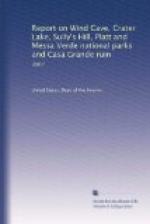The conquest of the country by the “Army of the West” attracted attention anew to the ruin, through the descriptions of Colonel Emory and Captain Johnston. The expedition passed up the Gila valley, and Colonel Emory, in his journal, gives a fanciful illustration and a slight description. The journal of Captain Johnston contained a somewhat better description and a rough but fairly good sketch. The best description of that period, however, was that given by John Russell Bartlett, in his “Personal Narrative,” published in 1854.
Bartlett observed that the ruin consists of three buildings, “all included within an area of 150 yards.” He described these buildings and gave ground plans of two of them and elevations of the principal structure. He also gave a translation of a portion of Font’s journal, as well as the previous description of Mange. He surmised that the central room of the main building, and perhaps the whole structure, was used for the storage of corn.
Bartlett’s account held place for nearly thirty years as the main reliance of compilers, and it forms today one of the most circumstantial and comprehensive descriptions extant. Other descriptions appeared at intervals of a few years, some compiled from Bartlett and Font, others based on personal observation, but none of them containing anything new, until the account of Mr. A. F. Bandelier, published some ten years ago,[1] is reached.
[Footnote 1: Archaeological Inst. of Amer., 5th Ann. Rep., 1884.]
Mr. Bandelier described the large group, of which the Casa Grande forms a part, and gave its dimensions as 400 meters (1,300 feet) north and south by 200 meters (650 feet) east and west. He also described and gave measurements of the Casa Grande proper and discusses its place in the field of aboriginal architecture. In a later publication[1] he discussed the ruin at somewhat greater length, and presented also a rough sketch plan of the group and ground plans of the Casa Grande and of the mound north of it. He gave a short history of the ruin and quite an extended account of the Pima traditions concerning it. He considered the Casa Grande a stronghold or fortress, a place of last resort, the counterpart, functionally, of the blockhouse of the early settlers of eastern United States.
[Footnote 1: Papers Archaeol.
Inst. of Amer., Amer. ser., iv,
Cambridge, 1892, p. 453 et
sec.]
In 1888 Mr. F. H. Cushing presented to the Congres International des Americanistes[1] some “Preliminary notes” on his work as director of the Hemenway southwestern archeological expedition. Mr. Cushing did not describe the Casa Grande, but merely alluded to it as a surviving example of the temple, or principal structure, which occurred in conjunction with nearly all the settlements studied. As Mr. Cushing’s work was devoted, however, to the investigation of remains analogous to, if not identical with, the Casa Grande, his report forms a valuable contribution to the literature of this subject, and although not everyone can accept the broad inferences and generalizations drawn by Mr. Cushing—of which he was able, unfortunately, to present only a mere statement—the report should be consulted by every student of southwestern archeology.




